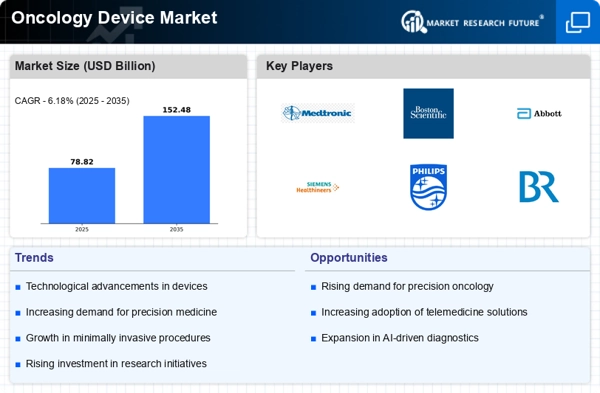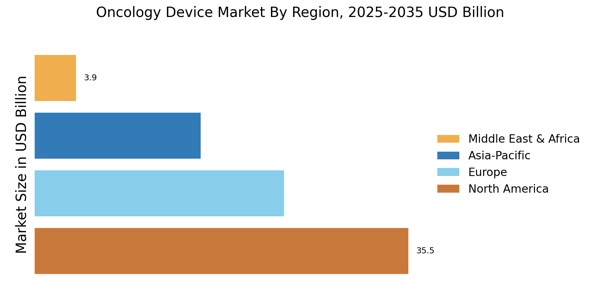Increasing Cancer Incidence
The Oncology Device Market is experiencing growth due to the rising incidence of cancer worldwide. According to recent statistics, cancer cases are projected to increase significantly, with estimates suggesting that by 2040, the number of new cancer cases could reach 29.5 million annually. This alarming trend necessitates the development and deployment of advanced oncology devices to facilitate early detection, diagnosis, and treatment. As healthcare systems strive to manage this growing burden, investments in innovative oncology devices are likely to surge, driving market expansion. Furthermore, the increasing awareness of cancer screening and preventive measures among populations contributes to the demand for sophisticated oncology devices, thereby enhancing the overall market landscape.
Advancements in Treatment Technologies
The Oncology Device Market is propelled by continuous advancements in treatment technologies. Innovations such as targeted therapies, immunotherapies, and personalized medicine are reshaping the treatment landscape for cancer patients. The integration of these advanced treatment modalities with oncology devices enhances their efficacy and precision. For instance, the development of next-generation sequencing technologies has revolutionized the way oncologists approach cancer treatment, allowing for tailored therapies based on individual genetic profiles. This shift towards personalized treatment is expected to drive the demand for advanced oncology devices, as healthcare providers seek to optimize patient outcomes. As a result, the Oncology Device Market is likely to witness substantial growth, fueled by the need for devices that can support these cutting-edge treatment approaches.
Regulatory Support for Innovative Devices
The Oncology Device Market is experiencing favorable regulatory support, which is crucial for the introduction of innovative oncology devices. Regulatory bodies are increasingly streamlining approval processes for new devices, thereby encouraging manufacturers to invest in research and development. This supportive environment facilitates the rapid introduction of cutting-edge technologies that can significantly improve cancer diagnosis and treatment. For example, the expedited approval pathways for breakthrough devices allow for quicker access to life-saving technologies for patients. As regulatory frameworks continue to evolve, the Oncology Device Market is expected to expand, driven by the influx of innovative devices that meet the growing needs of healthcare providers and patients alike.
Rising Demand for Home Healthcare Solutions
The Oncology Device Market is witnessing a shift towards home healthcare solutions, driven by the increasing demand for patient-centered care. Patients are increasingly seeking options that allow them to manage their health from the comfort of their homes, particularly in the context of cancer treatment. This trend is prompting manufacturers to develop oncology devices that are suitable for home use, such as portable diagnostic tools and remote monitoring systems. The convenience and accessibility of these devices are appealing to patients and healthcare providers alike, as they facilitate ongoing care and monitoring without the need for frequent hospital visits. Consequently, the Oncology Device Market is likely to grow as more innovative home healthcare solutions are introduced, catering to the evolving preferences of patients.
Growing Investment in Healthcare Infrastructure
The Oncology Device Market is benefiting from increased investment in healthcare infrastructure across various regions. Governments and private entities are recognizing the importance of enhancing healthcare facilities to address the rising cancer burden. This investment is directed towards upgrading medical equipment, including oncology devices, to ensure that healthcare providers can deliver high-quality care. For instance, the establishment of specialized cancer treatment centers is on the rise, which necessitates the procurement of advanced oncology devices. Additionally, funding for research and development in oncology is expanding, leading to the introduction of innovative devices that improve diagnostic and therapeutic capabilities. This trend is likely to bolster the Oncology Device Market, as enhanced infrastructure supports the adoption of advanced technologies.


















Leave a Comment